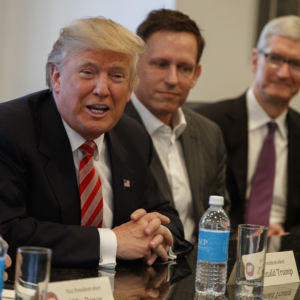The U.S. Chamber of Commerce released a report Tuesday detailing several federal labor board decisions that are in desperate need of reform.
Former President Barack Obama made major changes to labor law during his time in office. The National Labor Relations Board (NLRB) was a driving force behind these policies. The board issued the changes through case precedents when making decisions on labor dispute cases.
President Donald Trump now has a chance to upend these workplace decisions. The Workforce Freedom Initiative (WFI), a division within the Chamber, highlighted the most problematic decisions in its report. The report focuses on micro-unions, joint-employment, union elections, and employer rights, among others issues.
“The Obama-era NLRB’s flawed interpretation of the National Labor Relations Act led to a massive regulatory overreach that favored unions at all costs,” WFI Vice President Glenn Spencer said in a statement provided to InsideSources. “Congress and the Trump administration can restore common sense to labor law by appointing new Board members who will properly administer the NLRA, and by making sensible legislative fixes to the statute.”
The NLRB allowed unions to form a new type of bargaining unit known as micro-unions back in 2011. A micro-union focuses on a specialty group of employees instead of the entire workplace. Essentially, a union doesn’t need to get a majority vote to create a bargaining unit, but rather win support within a subgroup of workers.
“The Board’s new policy favors union interests because smaller groups of employees are typically easier to organize,” the report said. “As applied, the Specialty Healthcare decision means that the NLRB approves almost any bargaining unit proposed by a union, regardless of how small or fragmented.”
The report adds the decision may also violate the National Labor Relations Act (NLRA). The NLRB expanded what is known as the joint-employer standard during the last administration. The board can now more easily make an employer responsible for the employees and labor liabilities of a company it contracts with.
“The Board’s decision represented a significant policy change that expanded the types of businesses that may be deemed joint employers,” the report said. “The new standard has exposed a broad range of businesses to workplace liability for workplaces they do not control and workers they do not employ.”
The report adds the expanded standard overturned more than 30 years of case precedents. The standard used to be determined based on whether the company had direct control over the employees of the other. The new standard looks at indirect control, which critics argue is too vague.
“Direct and immediate control was generally understood to include the ability to hire, fire, discipline, supervise, and direct the other entity’s employees,” the report said. “By replacing the direct and immediate control standard with the ambiguous indirect and potential control test, the NLRB has made it difficult to predict which businesses will be liable for the workplace policies of another employer.”
The NLRB also made changes to how union elections are held. Those opposed have called the changes the ambush election rules because it shortens the amount of time union elections are held. The agency argued it was to streamline the process.
“Final Rule governing representation-case procedures is designed to remove unnecessary barriers to the fair and expeditious resolution of representation questions,” the NLRB has stated. “The Final Rule will streamline Board procedures, increase transparency and uniformity across regions, eliminate or reduce unnecessary litigation, duplication and delay.”
Those opposed have contested it allows unions to organize a workplace before employees really have the chance to understand everything. The report argues it also disenfranchises employers by limiting the time frame they can petition for a pre-election hearing.
“The ‘ambush election’ rule made significant changes to how election petitions are processed and how employers must respond to these petitions,” the report said. “In so doing, it reduced the time frame for representation elections from an average of 42 days to as few as 10.”
The report lists several more changes that the new administration should address. The issues primarily focus on employer rights. Recent decisions now allow unions to access employer email systems, and picket on company property. It also warns decisions have eroded management rights clauses which give employers the ability to manage their businesses without interference from the union.
Trump has a clear path to changing or completely upending these recent changes. The president gets to nominate the deciding vote on the five-member board. The new board could start deciding cases based on a revised or previous standard to set precedents for how future cases are decided.
The NLRB, however, wasn’t alone in making changes to workplace law. Trump could do away with executive orders by signing news ones, but other changes may be more difficult. Federal regulations, for instance, must be proposed, and go through a questioning and review process that could take months or even years.

